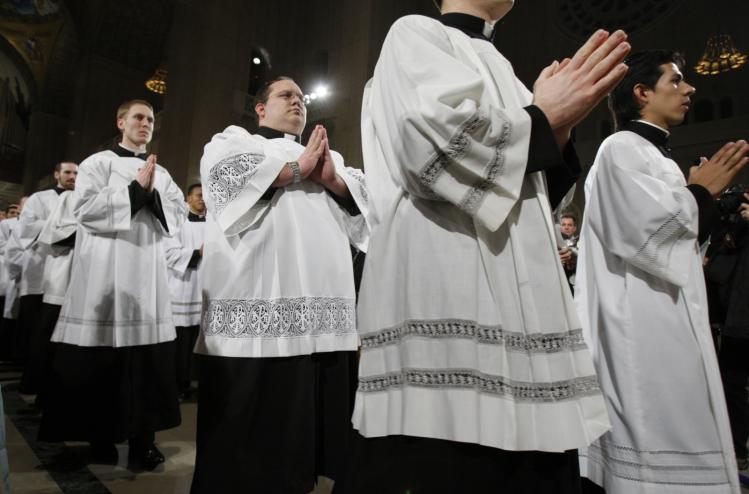
Michael Hannon’s “Against Obsessive Sexuality,” in which he replies to me and other critics of his First Things essay “Against Heterosexuality,” is helpful—although not primarily for the reasons he intends.
Its main service consists in underscoring just how radical his position is. He’s not just critical of homosexuality, or even heterosexual sin. He now also makes clear his qualms about heterosexual marriage, which he deems “lower in the hierarchy of human goods than the good of [celibate] Christian friendship.” (Hannon is himself about to enter religious life.) He elaborates:
It is not that the married state is wicked—it isn’t—but simply that it is less good than the celibate alternative. For marriage, which St. Paul identifies as a concession to human weakness, lacks the integration of a life consecrated totally to God. By its essential involvement with lower goods, married life diverts attention from the highest good. There is nothing evil in it, but its goodness is less pure than the celibate state, like an alloy compared with solid gold.
Notice how Hannon parts ways with fellow Catholic social conservatives such as Robert P. George, Sherif Girgis, and Ryan T. Anderson (co-authors of What is Marriage? Man and Woman: A Defense): for them, integrity is one of the “basic goods” that marriage is supposed to preserve. For Hannon, by contrast, the marital act provides a “particularly clear illustration” of disintegration, by diverting attention away from the divine.
This sex-negative position is nothing new: Indeed, it was the dominant Catholic tradition until Vatican II. It is still jarring to see it spelled out on the page. Although sex can be a volatile distraction—a point I acknowledged in my original critique—it can also be a positive, joyous, even stabilizing element of a well-integrated life. Many religious persons experience it as a gift from God rather than a diversion from Him.
Even more jarring is how Hannon either distorts or ignores the criticisms of his original essay. In that essay, he argued that religious conservatives should embrace queer theorists’ view that sexual orientation is a social construction, rather than a natural and inevitable feature of persons. His main concern was that sexual-orientation categories are an impediment to Christian chastity.
Hannon now contends that “almost all of [his] critics” complain that he has “misunderstood queer theory, because even if Foucault is right that sexual orientation is a cultural construct that was invented in the late nineteenth century, that doesn’t entail that sodomy is therefore evil.” He dismisses this criticism as silly, and surely it is. But I never make it, and I can’t find anyone else who does, either. (Hannon never mentions his critics by name.)
What I argued is this: Hannon misunderstands queer theory because he conflates the social construction of sexual orientation with its ready malleability. The fact that these categories arose historically doesn’t mean that we can simply decide to dismantle them, whether for political convenience or distorted pastoral goals.
It’s those distorted pastoral goals that worry me most. Hannon cites a passage from my reply to him, in which I describe a young boy (myself, actually) who feels an amorphous excitement watching his neighbor mow the lawn. Hannon and I agree that, insofar as possible, society should provide that boy and his peers with social structures to help channel that amorphous excitement into healthy and moral outlets. We disagree about whether healthy and moral outlets can eventually include romantic relationships with persons of the same sex, but we don’t hash out that disagreement here. (For those who are interested, I make my case in a short book and some videos.)
Yet one need not approve of homosexual conduct to recognize the fundamental cluelessness of Hannon’s gloss on the passage. Allow me to quote him at length:
A young child captivated by the lawn-mowing boy next door could be experiencing a couple of entirely legitimate things. First, he could be recognizing the beauty of the boy and desiring to delight in it. Second, he could be recognizing the goodness of the boy and desiring to move towards it. Both of these are totally appropriate reactions, because it’s true that the boy is both beautiful and good. The moral question we’re left with is how he ought to delight in the boy’s beauty and move towards his good. The end having been determined, what are the proper means for attaining it?
The libertines would say that, finally, what satisfies these young boys’ desires towards persons of the same sex is genital delight and romantic intimacy. I think that’s ridiculous, not only because such a sexual union would be immoral and thus could never bring about happiness, but also because it’s an insult to the boys’ true potential intimacy. The relationship perfective of these boys’ longing for union is not marriage but friendship, which, believe it or not, is a far better thing anyway.
As one of those “libertines,” I have several reactions, beyond my already expressed surprise at Hannon’s position on marriage.
For one thing, the idea that such sexual unions “could never bring about happiness” simply flies in the face of overwhelming evidence. I know that Hannon would say that, even though the growing number of out-and-proud same-sex couples in this country seem happy, deep down they’re really not. He would say it, but fewer and fewer Americans would believe it, and rightly so. It’s not just because they defer to individuals as the experts on their own happiness. (People can delude themselves, after all.) It’s because they see the positive fruits such relationships bear.
What strikes me most, however, is how Hannon ignores two key details. I didn’t mention them explicitly in the original story, because I thought they went without saying. Mea culpa. So here goes:
First, this particular boy feels such excitement in the presence of lawn-mowing boys, but not in the presence of lawn-mowing girls. If what’s happening here were simply delight in beauty and goodness, then we would have to wonder at the boy’s immunity to such objects when they’re presented in female form.
But that’s not (or at least, not merely) what’s happening here. The reason we know so is the second detail: the boy’s amorphous excitement sometimes includes erections.
Again, I don’t expect Hannon to see eye-to-eye with me on the morality of homosexual conduct. But you don’t have to be a “libertine” to recognize that what the young boy is experiencing is not just a really, really, really strong desire for friendship. More important, you don’t have to be a libertine to acknowledge that willful blindness to what the boy is actually experiencing can do serious, lasting damage.
And that’s where “Against Obsessive Sexuality” is most disappointing: Hannon barely acknowledges, much less addresses, my central pastoral worry—that by attempting to dismantle the vocabulary of sexual orientation, we effectively restore the cruel and inhumane regime of the closet. We return to a time when homosexuality was not merely “the love that dare not speak its name” but the love that could not speak it. We sentence this boy to confusion and isolation.
Perhaps this result is unsurprising, given Hannon’s view that virtually any sexuality is “obsessive” sexuality. It is disturbing nevertheless.
Please email comments to [email protected] and join the conversation on our Facebook page.
